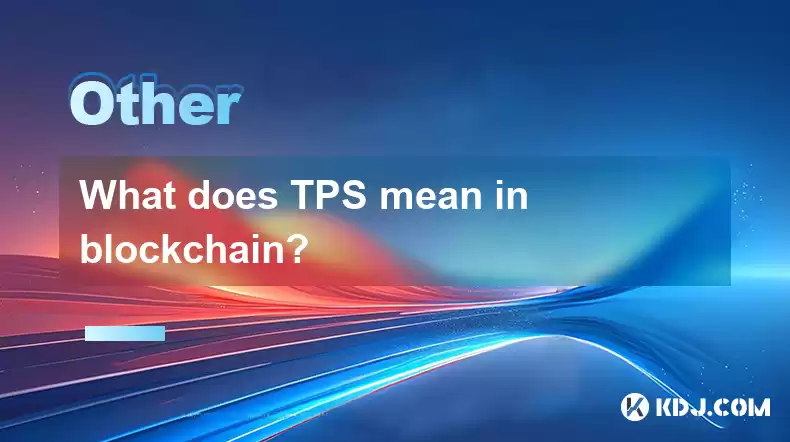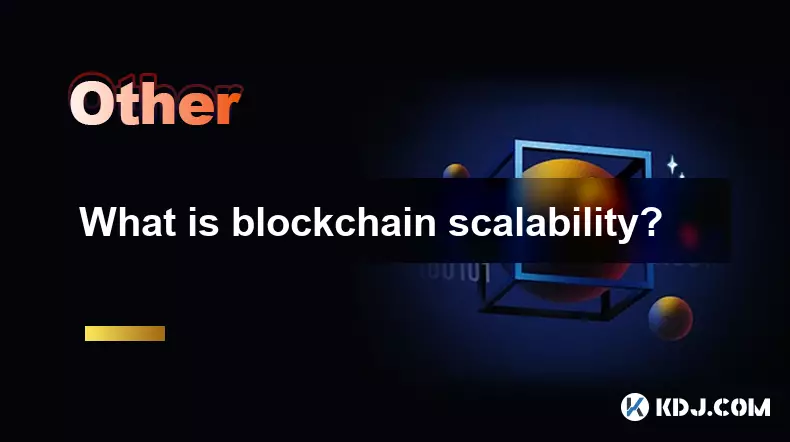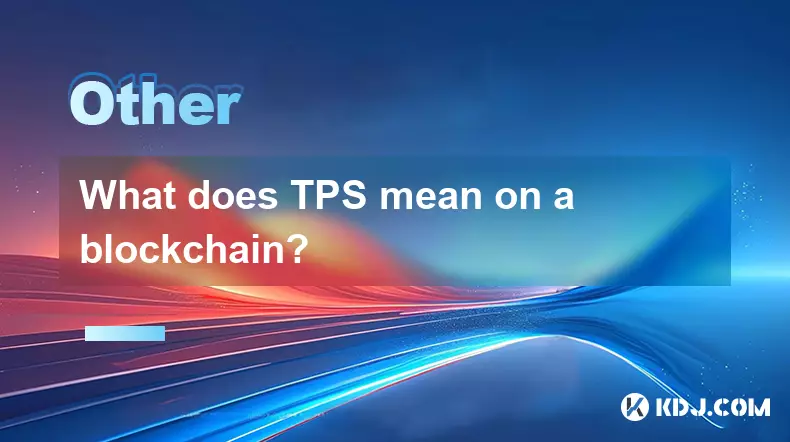-
 bitcoin
bitcoin $109667.069529 USD
-3.03% -
 ethereum
ethereum $3936.685804 USD
-4.07% -
 tether
tether $1.000493 USD
0.01% -
 xrp
xrp $2.771823 USD
-4.74% -
 bnb
bnb $957.805027 USD
-5.34% -
 solana
solana $196.735100 USD
-6.68% -
 usd-coin
usd-coin $0.999727 USD
-0.01% -
 dogecoin
dogecoin $0.227355 USD
-5.12% -
 tron
tron $0.335205 USD
-0.81% -
 cardano
cardano $0.779256 USD
-3.59% -
 ethena-usde
ethena-usde $0.999900 USD
-0.06% -
 hyperliquid
hyperliquid $42.492095 USD
-6.61% -
 chainlink
chainlink $20.501853 USD
-4.34% -
 avalanche
avalanche $28.952606 USD
-11.21% -
 stellar
stellar $0.356038 USD
-3.93%
What does TPS mean in blockchain?
Blockchain's TPS (Transactions Per Second) measures processing capacity, varying widely across networks. Higher TPS generally means better performance, but often compromises decentralization or security; finding the right balance is key.
Mar 16, 2025 at 03:20 pm

- TPS stands for Transactions Per Second, a crucial metric measuring a blockchain's processing capacity.
- Different blockchains have vastly different TPS capabilities, impacting their scalability and suitability for various applications.
- Factors influencing TPS include block size, block time, and consensus mechanism.
- High TPS is generally desirable but comes with trade-offs, often involving decentralization or security.
- Understanding TPS is essential for evaluating a blockchain's potential and limitations.
Transactions Per Second (TPS) is a critical metric in the cryptocurrency world that quantifies the number of transactions a blockchain network can process within a single second. It's a key indicator of a blockchain's scalability and its ability to handle a large volume of transactions efficiently. A higher TPS generally suggests better performance and the potential for wider adoption. However, it's crucial to consider this metric in context with other factors.
How is TPS Calculated?Calculating TPS isn't a straightforward process, as it depends on various factors and can fluctuate significantly. It's not simply a fixed number. Generally, it involves observing the number of confirmed transactions processed over a specific period, usually a second, and then averaging those results over a longer timeframe to account for variations. This requires monitoring the blockchain's activity and analyzing the data. Different methods and tools exist for this purpose.
Factors Affecting Blockchain TPSSeveral factors influence a blockchain's TPS. Block size, for example, directly impacts the number of transactions that can fit within a single block. Larger blocks accommodate more transactions, increasing the TPS. Block time, the interval between creating consecutive blocks, also plays a crucial role. Shorter block times lead to higher TPS.
The consensus mechanism employed by the blockchain is another significant factor. Proof-of-Work (PoW) blockchains, like Bitcoin, generally have lower TPS than Proof-of-Stake (PoS) blockchains, like Cardano or Solana. This difference stems from the inherent differences in transaction validation processes. PoW requires extensive computational power, slowing down transaction processing. PoS mechanisms are often more efficient.
Different Blockchains and Their TPSDifferent blockchains boast vastly different TPS capabilities. Bitcoin, known for its security and decentralization, has a relatively low TPS, typically in the single digits. Ethereum, while undergoing upgrades to enhance its scalability, still faces limitations in TPS compared to newer platforms. In contrast, some newer blockchains, built with scalability in mind, boast significantly higher TPS figures. Solana, for example, has claimed exceptionally high TPS, though these claims are often debated within the community.
The variation in TPS across different blockchains reflects the design choices made during their development. Some prioritize security and decentralization over speed, while others prioritize speed and scalability. The optimal TPS depends on the specific use case of the blockchain. A blockchain designed for microtransactions might require a far higher TPS than one primarily used for storing value.
The Trade-offs Involved in High TPSWhile a high TPS is generally desirable, it often comes with trade-offs. Increasing TPS might necessitate compromises on decentralization or security. For instance, to achieve very high TPS, a blockchain might rely on centralized components, potentially reducing its resistance to censorship or single points of failure. Similarly, speeding up transaction processing could sometimes compromise the security and integrity of the network.
It's crucial to understand that the pursuit of high TPS should not come at the expense of other essential aspects of a robust blockchain. A balance must be struck between speed, security, and decentralization. The ideal TPS varies depending on the specific application and priorities of the blockchain.
TPS and Scalability SolutionsThe pursuit of higher TPS has led to the development of various scalability solutions within the blockchain space. Layer-2 scaling solutions, such as Lightning Network for Bitcoin and various rollup technologies for Ethereum, aim to enhance transaction throughput without compromising the underlying blockchain's security or decentralization. These solutions essentially offload some of the transaction processing to separate networks, improving overall efficiency.
Sharding, another common scalability technique, involves partitioning the blockchain into smaller, more manageable fragments called shards. Each shard can process transactions concurrently, leading to a significant increase in TPS. This method aims to distribute the processing load, mitigating the scalability limitations of a single, monolithic blockchain.
Common Questions and Answers:Q: Is higher TPS always better?A: Not necessarily. Higher TPS often comes with trade-offs, potentially sacrificing decentralization or security. The optimal TPS depends on the specific use case and priorities of the blockchain.
Q: How does TPS relate to transaction fees?A: High demand and limited TPS can lead to increased transaction fees as users compete for processing space on the blockchain.
Q: Can TPS be improved on existing blockchains?A: Yes, through various scalability solutions like layer-2 scaling and sharding, existing blockchains can improve their TPS. However, this often involves complex technological upgrades.
Q: What are some examples of blockchains with high TPS?A: Solana, Cardano, and some other newer platforms often claim very high TPS, though these numbers are sometimes contested. It's important to critically evaluate such claims.
Q: How can I find the current TPS of a blockchain?A: Various blockchain explorers and monitoring websites provide real-time data on transaction throughput for many different blockchains.
Disclaimer:info@kdj.com
The information provided is not trading advice. kdj.com does not assume any responsibility for any investments made based on the information provided in this article. Cryptocurrencies are highly volatile and it is highly recommended that you invest with caution after thorough research!
If you believe that the content used on this website infringes your copyright, please contact us immediately (info@kdj.com) and we will delete it promptly.
- AlphaTON's Bold Bet: Toncoin, Balance Sheets, and the Future of Digital Treasuries
- 2025-09-27 04:45:15
- Crypto Kidnapping in Minnesota: A New York Minute Breakdown of the $8 Million Heist
- 2025-09-27 04:25:14
- Avalanche, RUVI, and the Altcoin Rush: What's Fueling the Fire?
- 2025-09-27 04:25:14
- Ripple's RLUSD Takes Center Stage: Bybit Listing and Derivatives Market Potential
- 2025-09-27 05:05:12
- Bitcoin, Ethereum, and ETF Outflows: What's Shakin' in Crypto?
- 2025-09-27 05:25:13
- Worldcoin's WLD: Support Rebound or Further Decline? A New Yorker's Take
- 2025-09-27 05:05:12
Related knowledge

What is a token economy?
Sep 20,2025 at 12:18am
Understanding the Foundations of a Token Economy1. A token economy in the context of cryptocurrency refers to a system where digital tokens are used a...

What are suitable application scenarios for blockchain?
Sep 20,2025 at 03:19am
Decentralized Finance (DeFi) Platforms1. Blockchain enables the creation of financial services without centralized intermediaries, allowing users to l...

What is a Rollup (Optimistic vs. ZK)?
Sep 22,2025 at 03:00pm
Understanding Rollups in Blockchain Technology1. Rollups are layer-2 scaling solutions designed to increase transaction throughput on blockchains like...

What is blockchain scalability?
Sep 19,2025 at 06:18am
Understanding Blockchain Scalability1. Blockchain scalability refers to a network's ability to handle an increasing number of transactions without com...

What does TPS mean on a blockchain?
Sep 21,2025 at 09:54am
Understanding TPS in Blockchain Technology1. TPS stands for Transactions Per Second, a metric used to measure the number of transactions a blockchain ...

What is a multi-signature wallet
Sep 20,2025 at 07:00am
Understanding Multi-Signature Wallets in Cryptocurrency1. A multi-signature wallet, often referred to as a multisig wallet, is a type of cryptocurrenc...

What is a token economy?
Sep 20,2025 at 12:18am
Understanding the Foundations of a Token Economy1. A token economy in the context of cryptocurrency refers to a system where digital tokens are used a...

What are suitable application scenarios for blockchain?
Sep 20,2025 at 03:19am
Decentralized Finance (DeFi) Platforms1. Blockchain enables the creation of financial services without centralized intermediaries, allowing users to l...

What is a Rollup (Optimistic vs. ZK)?
Sep 22,2025 at 03:00pm
Understanding Rollups in Blockchain Technology1. Rollups are layer-2 scaling solutions designed to increase transaction throughput on blockchains like...

What is blockchain scalability?
Sep 19,2025 at 06:18am
Understanding Blockchain Scalability1. Blockchain scalability refers to a network's ability to handle an increasing number of transactions without com...

What does TPS mean on a blockchain?
Sep 21,2025 at 09:54am
Understanding TPS in Blockchain Technology1. TPS stands for Transactions Per Second, a metric used to measure the number of transactions a blockchain ...

What is a multi-signature wallet
Sep 20,2025 at 07:00am
Understanding Multi-Signature Wallets in Cryptocurrency1. A multi-signature wallet, often referred to as a multisig wallet, is a type of cryptocurrenc...
See all articles










































































